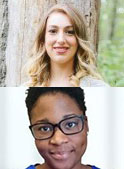 By Cristina Peter & Ayana Webb, Whole Student Development Team
By Cristina Peter & Ayana Webb, Whole Student Development Team
One of the strengths of the Innovation Hub is its flexibility; the way we can adapt our process to fit the users (i.e. the students). Our goal is to inform our process while gathering information to continuously inform our process. Clear as mud? Probably. The process of innovation that we are embarking upon is quite unique to many processes we are familiar with. Our usual methods of data collection are carefully planned and meticulously executed; however can we really capture our ever-changing student population by narrowly defining what we want to capture? Or might it be interesting to instead tailor our tools to discover how students are captured best. While we don’t want our parameters to be constrictive, parameters are certainly helpful…especially when embarking on a series of student interviews.
During our first meeting, the Whole Student Development team struggled to really define what we meant by “Whole Student Development”. Most of us had an intuitive grasp of what we meant, but it was difficult to truly articulate what we were looking for when we thought about “wholly developed students”. What students should we interview? How could we be sure we were interviewing a broad range of students? How could we select students strategically? Could we create some parameters that would help us inform our process, without stifling the information that was offered in our interviews?
It was helpful to employ a framework that we could work within as a means of organizing our research plan. Our group chose the 8 Dimensions of Wellness as a framework for understanding the facets of “whole development” in our students. The dimensions are: emotional, environmental, financial, intellectual, occupational, physical, social, and spiritual. During undergraduate or postsecondary study, there is incredible growth and development in each of these areas and there are also identifiable “extremes” within each of these dimensions. For example, in identifying “extreme users” for the intellectual wellness dimension, we thought of interviewing academic award winners as well as students who may have experienced academic struggles. While we most likely would have come to the conclusion to identify and interview these students, the framework provides us with a sort of “checklist” of ensuring that we are interacting with a wide range of students and a wide range of definitions of “whole development”.
With a clear organizational framework, we selected “extreme users” of each dimension and then reached out to students, however, no students have been told what “dimension” they were selected for. We will be asking the same question to all students regardless of the “dimension” we had been interested in better understanding. In this case the “tool” of research, the 8 Dimensions, was a method of organizing who we choose to interact with as a means of connecting with a wide pool of unique experiences; however the tool does not impact what we ask students and therefore should allow the student to respond in a way that represents them and their experience. And with that, we shall see what kinds of information we gather!
0 comments on ““Defining” Whole Student Development”